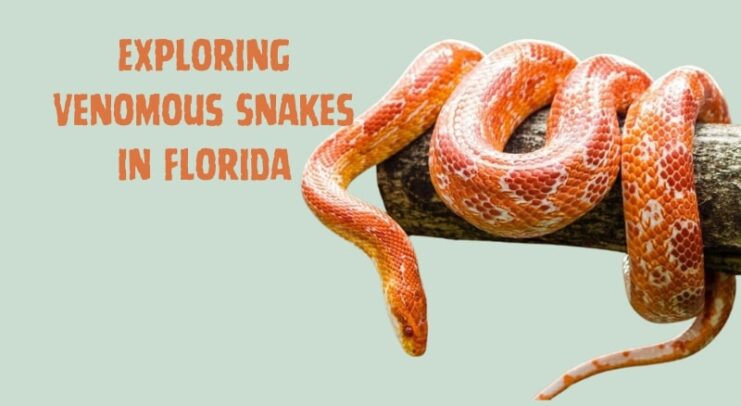Florida is a great place, known for its sunny beaches and fun culture. But did you know it’s also home to some pretty interesting snakes? Some of these snakes can be dangerous because they’re venomous, but they’re also really important for the environment. This article is going to tell you all about them.
Let’s start with a little story. Imagine you’re out for a walk on a sunny day in Florida. You’re enjoying the sounds of the birds and the rustling leaves. Suddenly, you see something colorful in the bushes. You look closer and realize it’s a snake! It’s a Coral Snake, one of the venomous snakes that live in Florida. Even though it might be a bit scary to see a snake, it’s also a reminder of all the different kinds of wildlife that live in Florida.
In this article, we’re going to learn more about these snakes. We’ll talk about different types of venomous snakes, like the Pit Vipers and the Coral Snake. We’ll learn about where they live, what they look like. So, whether you live in Florida, plan to visit, or are just curious, come along as we learn about Florida’s venomous snakes.
Florida’s Predominant Pit Vipers
Pit Vipers, named for the heat-sensitive pits on their faces, make up the majority of venomous snakes in Florida. These include the Eastern Diamondback Rattlesnake, the Timber Rattlesnake, the Copperhead, and the Cottonmouth or Water Moccasin.
1. Eastern Diamondback Rattlesnake
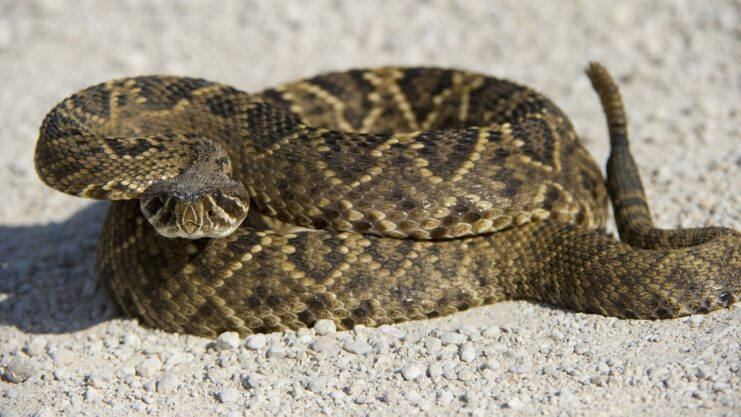
The Eastern Diamondback Rattlesnake, scientifically known as Crotalus adamanteus, is a fascinating creature that holds the title of North America’s longest and heaviest venomous snake. Averaging between 3 to 6 feet in length, some adults have been known to grow up to an impressive 8 feet. This snake is easily identifiable by its diamond-shaped pattern along its back, which is the source of its common name. It also has a distinctive black band that covers its eyes, outlined by two pale lines. The Eastern Diamondback is well-known for its iconic rattle and its venomous bite, which can be fatal to humans. However, human fatalities are rare due to the availability of antivenom throughout its range.
It is endemic to the southeastern United States, primarily found in the pinelands of Florida, the coastal plains of North Carolina, and from southern Mississippi through eastern Louisiana. They prefer scrublands, coastal forests, barrier islands, and pine and wiregrass flatwoods, but can also be found in slightly more moist areas such as wet prairies or savannas and around the borders of wetlands. Despite their preference for dry areas, these snakes are adept swimmers and will occasionally swim in saltwater between barrier reefs and along the edges of swamps.
Key information:
- Known for its venomous bite which can be fatal to humans
- Prefers scrublands, coastal forests, barrier islands, and pine and wiregrass flatwoods
- Can swim in saltwater
- Mates in the late summer and fall, giving birth six to seven months later
- Newborns are 15 inches long and similar to adults in color and pattern
- Most active in the evenings and early mornings (crepuscular)
- Hibernates in cold winters in gopher tortoise or mammal burrows, hollow logs, stumps, or among tree roots
- Can live for 20 years or more
2. Timber Rattlesnake
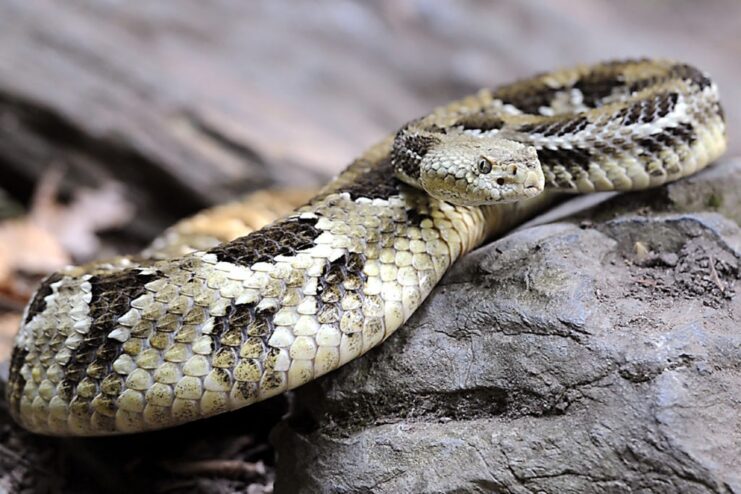
They are gray, sometimes with a pinkish hue, and have a stripe down their back. This stripe can be orange, yellow, or pinkish in some timber rattlesnakes, while others have a brown or black stripe. It is known for its characteristic rattles or “buttons” at the tip of its tail. When threatened, it props itself up and shakes its rattle, producing a rapid, crisp rattling sound as a warning before it strikes.
They have a wide distribution across the eastern half of the United States. Their range extends from eastern Kansas, Texas, Iowa, and central Wisconsin to Georgia, the Carolinas, West Virginia, western Virginia, Pennsylvania, and New England. They live in a variety of habitats, including mountainous or hilly forests, hardwood or pine forests, swamps, river floodplains, lowland cane thickets, and agricultural fields.
Statistics:
- Average Length: 2.5-5 feet (some reports of up to 7 feet)
- Habitat: Wide distribution across the eastern half of the United States
- Lifespan: around 16-22 years
3. Copperhead
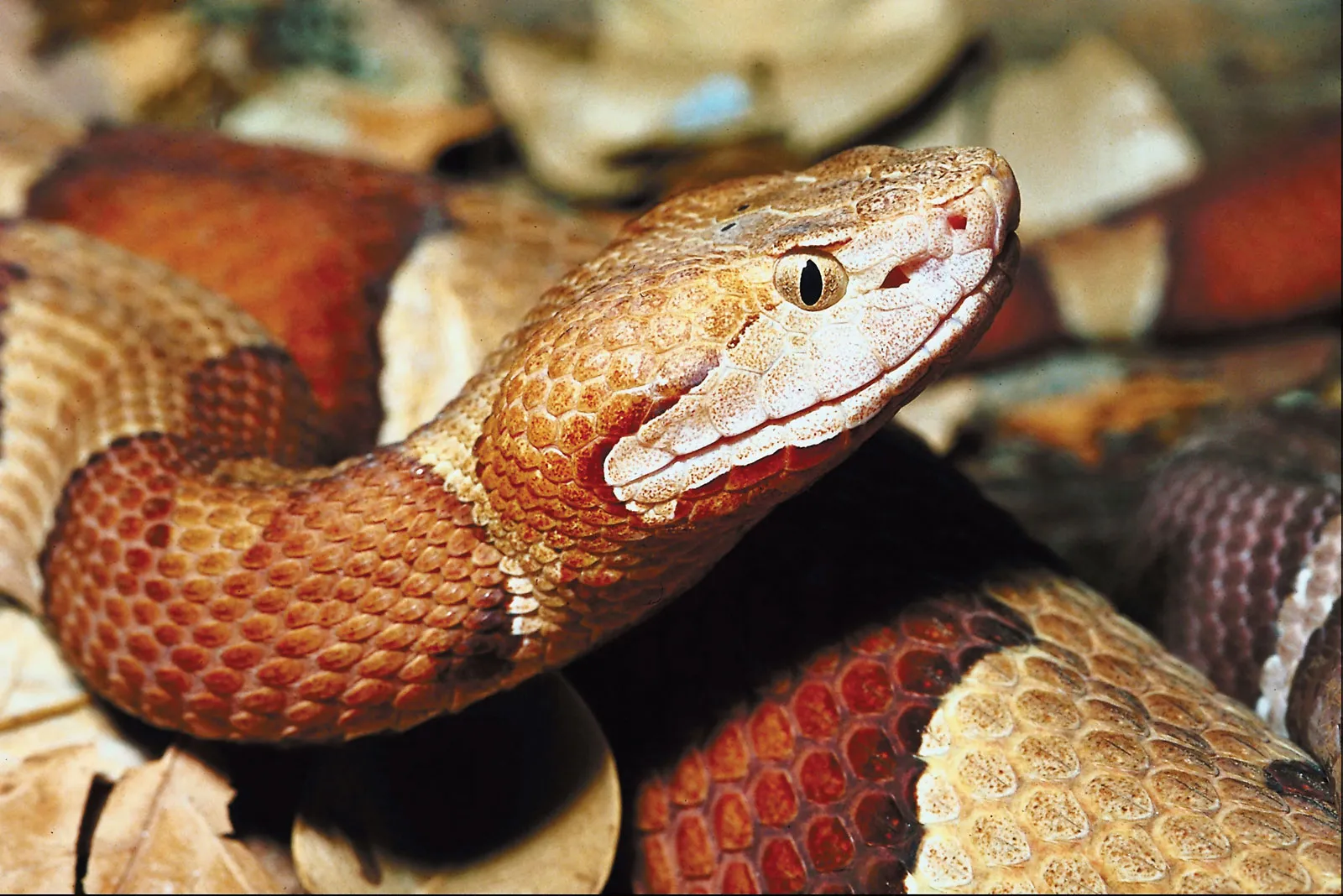
Copperheads are pit vipers, a group that also includes rattlesnakes and water moccasins. They have heat-sensory pits between their eyes and nostrils, which allow them to detect minute differences in temperature and accurately strike their prey.
Copperheads are medium-sized snakes, with adults averaging between 2 and 3 feet in length. Their bodies are patterned with dark, chestnut-brown or reddish-brown crossbands on a background of lighter brown, tan, salmon, or pinkish color. These crossbands are shaped like an hourglass, dumbbell, or saddlebag, making them easily identifiable. Copperheads are the only snakes with hourglass-shaped markings.
They help control the population of their prey, which includes various pests. For instance, they eat a lot of rodents, which can cause diseases and problems. By consuming these rodents, copperheads also help control the tick population, which can transmit diseases like Rocky Mountain spotted fever and Lyme disease. Interestingly, recent research has found that the venom of copperhead snakes may contain compounds that could be used in cancer treatments.
4. Cottonmouth or Water Moccasin
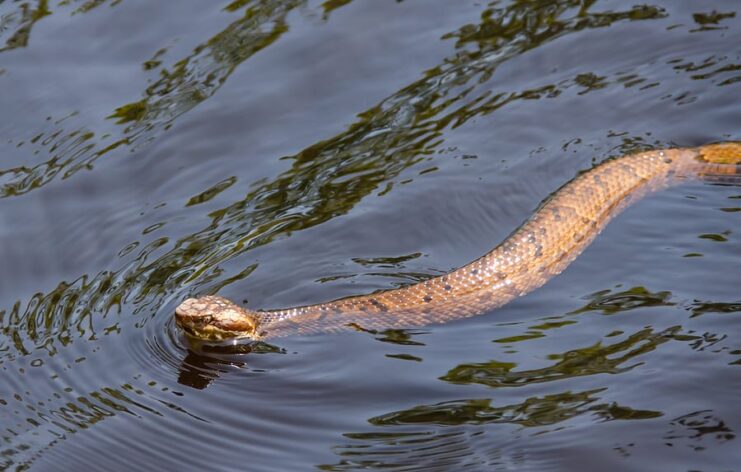
The Cottonmouth, also known as the Water Moccasin, is a venomous snake that you can find in the southeastern United States. They got their name “Cottonmouth” because when they feel threatened, they open their mouth wide to show off the white color inside, just like cotton! They are comfortable both in water and on land, which is why some people also call them Water Moccasins.
These snakes are pretty big, usually between 2 to 4 feet long. They have thick body and a big head. You can recognize them by their dark stripes next to each nostril and their color, which can be dark brown, black, olive, or even yellow. But be careful not to confuse them with nonvenomous water snakes, which look similar but are thinner and have round pupils, not vertical ones like the Cottonmouth.
Key Information:
- Rarely bites humans unless provoked
- Lives in aquatic and wetland habitats, like swamps, marshes, ponds, lakes, and streams
- Hunts mostly at night, especially in the summer
- Eats fish, small mammals, birds, amphibians, and reptiles
- Gives birth to live young every two to three years
5. The Colorful Coral Snake
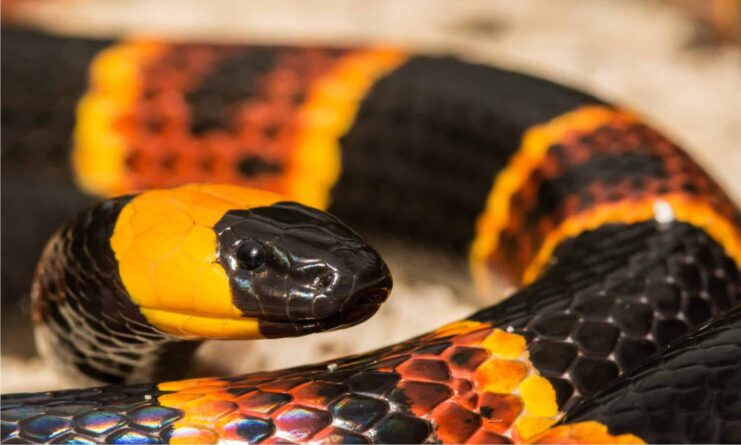
The Eastern Coral Snake, also known as the Harlequin Coral Snake, holds the title of being the sole Coral Snake species found in Florida. This snake is easily identifiable due to its unique pattern of vibrant bands. A black snout and the presence of red bands adjacent to yellow ones set it apart from non-venomous species that may bear a resemblance.
While they are venomous, these snakes are instrumental in maintaining the balance of the ecosystem. They help control the rodent population, thus aiding in the prevention of disease spread. Furthermore, they are an integral part of the food chain, providing sustenance for various birds and mammals.
Key Features:
- Species: Eastern or Harlequin Coral Snake
- Average Adult Size: 20 to 30 inches
- Distinctive Features: Black snout, red bands touching yellow bands
- Role in Ecosystem: Control rodent populations, prevent disease spread, and serve as prey for birds and mammals.
Safety Measures and Coexistence
While it’s essential to be aware of the potential danger posed by these venomous snakes, it’s equally important to respect their role in the ecosystem.
When you encounter a venomous snake, it’s crucial to take specific safety measures to avoid any potential harm. Here are some guidelines:
- Maintain a Safe Distance: Always keep a safe distance from the snake, at least 6 feet away. This distance is generally outside of their striking range.
- Do Not Attempt to Handle the Snake: Never try to handle or kill the snake. Most bites occur when people try to kill or capture snakes.
- Do Not Corner the Snake: If the snake feels threatened or cornered, it may become defensive and strike. Allow the snake a clear path to escape.
- Keep Pets and Children Away: Keep children and pets away from the area where the snake is located.
- Contact a Professional: If the snake is in your home or another area where it poses a threat, contact a professional wildlife removal or pest control service.
Venomous Snake Habitats and Prey
If you want to learn more about these venomous snakes, including their habitats and common prey, take a look at the table below:
| Snake Species | Primary Habitats | Common Prey |
|---|---|---|
| Eastern Diamondback Rattlesnake | Dry sandy areas, palmetto or wiregrass flatwoods, coastal scrub habitats | Small mammals, birds |
| Timber Rattlesnake | Deciduous forests, rocky outcrops | Small mammals, birds |
| Copperhead | Wooded and mixed pasture lowlands | Mice, birds, amphibians, insects |
| Cottonmouth or Water Moccasin | Swamps, marshes, ponds, lakes, and streams | Fish, amphibians, reptiles, small mammals, birds |
| Coral Snake | Wooded, sandy areas, marshes | Other snakes, lizards |
Safety Tips to Prevent Snake Encounters
Prevention is the best way to avoid potential snake bites. Here are some tips to reduce the likelihood of encountering a venomous snake:
- Keep Your Yard Clean: Snakes are attracted to areas that provide them with cover and food. By keeping your yard clean and free of debris, such as piles of wood or leaves, you can make your property less attractive to snakes.
- Seal Off Potential Hiding Places: Check your home and outbuildings for any gaps or holes where snakes could enter or hide. Seal these off to prevent snakes from making a home there.
- Be Aware When Outdoors: When hiking or walking in nature, stick to well-used trails. Avoid tall grass, piles of leaves, and heavy underbrush where snakes may be hiding.
- Use a Flashlight at Night: Snakes are often active at night. Always use a flashlight when moving around outside in the dark.
- Wear Protective Clothing: If you’re in an area known to have venomous snakes, wear boots and long pants. This can provide an extra layer of protection against bites.
- Educate Yourself and Your Family: Learn about the types of venomous snakes that live in your area. Teach your family how to identify them and what to do if they encounter one. Knowledge is one of the best forms of protection.
FAQs
How can I prevent snake encounters?
To prevent snake encounters, keep your yard clean and free of debris, seal off potential hiding places, be aware when outdoors, use a flashlight at night, wear protective clothing in areas known to have venomous snakes, and educate yourself and your family about the types of venomous snakes in your area.
Are venomous snakes dangerous to humans?
While venomous snakes can pose a threat to humans, most snakes are generally shy and avoid human interaction. They only bite as a last resort when they feel threatened and cornered. Most human fatalities are rare due to the availability of antivenom.
How does the Copperhead snake contribute to disease control?
Copperheads help control the population of their prey, which includes various pests like rodents that can cause diseases. By consuming these rodents, copperheads also help control the tick population, which can transmit diseases like Rocky Mountain spotted fever and Lyme disease.
How can I identify a Coral Snake?
The Eastern Coral Snake is easily identifiable due to its unique pattern of vibrant bands. A black snout and the presence of red bands adjacent to yellow ones set it apart from non-venomous species that may bear a resemblance.
Why is the Cottonmouth also known as the Water Moccasin?
The Cottonmouth is also known as the Water Moccasin because it is comfortable both in water and on land. The name “Cottonmouth” comes from the snake’s defensive behavior of opening its mouth wide to show off the white color inside, which resembles cotton.
Conclusion
Venomous snakes, while potentially dangerous, are a vital part of Florida’s rich biodiversity. With knowledge, respect, and awareness, we can live alongside these creatures without fear. Remember, the goal is not to eliminate these snakes but to understand and respect them.
Even as we delve into the intriguing world of Florida’s venomous snakes, a comparison with their counterparts in other parts of the US, like Idaho, can be enlightening. You can learn more about Idaho’s venomous snakes here.
Related Posts:
- Are There Venomous Snakes in Hawaii? Revealing the…
- Venomous Snakes in Colorado: Exploring the Rocky…
- Unveiling Venomous Snakes in Georgia: An Exciting…
- Top 10 Best Camping Spots in Florida: Experience the…
- 7 Biggest Fish in Florida: Get Ready to Be Speechless!
- Discover the Best Online Pokies in New Zealand: A…

